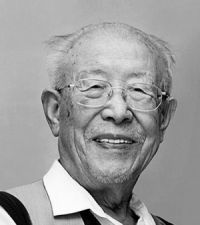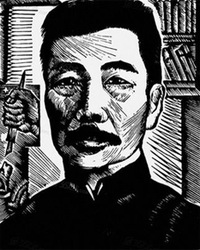Li Qun
Li Qun (Chinese:力群) was a centenarian woodcut artist, best known for his hard-lined portrait of Lu Xun, one of China’s most influential authors in the early 20th century.
Born Hao Lichun (郝丽春) in Linshi County, Shanxi Province, in Dec. 1921, Li sided with the China Left Wing Artist Association, a pro-Communist Party of China (CPC) organization. He was the last living witness to Mao Zedong’s Talks at Yan’an Conference on Literature and Art in 1942, a monumental speech influencing China’s ensuing proletarian culture. His death due to lung failure on Feb. 10, 2012, brought with him the last tinge of that voice.
Enrolled by Hangzhou National Art School in 1931, Li, as enlightened as many of his peers, gained his early inspiration from the iconic author Lu who wrote satirical stories, mostly against establishment and authorities.
With great enthusiasm and perseverance, Li rose to fame in 1936 with his commemorative woodcut portraits of Lu, who died that same year. In 1940, his prominence won him a position at the Lu Xun Art Academy in Yan’an, a CPC’s revolutionary center prior to 1949 in Shaanxi Province.
His influence expanded after the founding of People’s Republic of China, and he became a leader inside the country’s literary and art circle. In the 1960s, he toured around the country and carved on pieces of woods the lively scenes he saw along the trip. He became the president of Shanxi Province picture studio, committee member of the China Federation of Literary and Art Circles, managing director of the China Artists Association and vice-president of China Woodcut Association in 1977, a year after the end of the Cultural Revolution (1966-1976).
Renowned contemporary poet Ai Qing praised Li’s craft as “lyric poetry engraved on wood block.”
Li gave generously during his final years: Over 100 works to public museums, including China Academy of Art and Li Qun Art Gallery in his hometown.
Li Qun, pioneer in Chinese woodcut [1]

